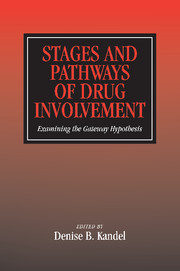Book contents
- Frontmatter
- Contents
- List of Contributors
- Foreword
- Preface
- Part I Overview
- Part II Recent Substantive Findings: What Do We Know About Stages of Drug Use, Risks, and Protective Factors?
- 2 Drug Sequences, Age of Onset, and Use Trajectories as Predictors of Drug Abuse/Dependence in Young Adulthood
- 3 Substance Use Norms and Transitions in Substance Use: Implications for the Gateway Hypothesis
- 4 Stages of Drug Involvement in the U.S. Population
- 5 Substance Use Progression and Hard Drug Use in Inner-City New York
- Part III Impact of Prevention Interventions: A Test of the Progression Hypothesis
- Part IV Methodological Issues and Approaches: Advantages and Limitations of Alternate Methods
- Part V Animal Models and Biological Processes: Implications for Drug Progression
- Part VI Conclusion
- Index
3 - Substance Use Norms and Transitions in Substance Use: Implications for the Gateway Hypothesis
Published online by Cambridge University Press: 25 July 2009
- Frontmatter
- Contents
- List of Contributors
- Foreword
- Preface
- Part I Overview
- Part II Recent Substantive Findings: What Do We Know About Stages of Drug Use, Risks, and Protective Factors?
- 2 Drug Sequences, Age of Onset, and Use Trajectories as Predictors of Drug Abuse/Dependence in Young Adulthood
- 3 Substance Use Norms and Transitions in Substance Use: Implications for the Gateway Hypothesis
- 4 Stages of Drug Involvement in the U.S. Population
- 5 Substance Use Progression and Hard Drug Use in Inner-City New York
- Part III Impact of Prevention Interventions: A Test of the Progression Hypothesis
- Part IV Methodological Issues and Approaches: Advantages and Limitations of Alternate Methods
- Part V Animal Models and Biological Processes: Implications for Drug Progression
- Part VI Conclusion
- Index
Summary
Specific progressions or stages of drug initiation in adolescence have been identified (Collins, Graham, Rousculp, Fidler, Pan, & Hansen, 1994; Kandel, Kessler, & Margulies, 1978; Kandel & Davies, 1992; for a review, see Kandel, Yamaguchi, & Chen, 1992). The typical sequence begins with either alcohol or tobacco, followed by marijuana, which is followed by other illicit drugs. This sequence is relatively robust and has been replicated in retrospective data (Kandel et al., 1992), prospective data (Collins et al., 1994), and in international data (Adler & Kandel, 1981).
However, the determinants of this sequence are less clear. Why does the sequence begin with alcohol or tobacco? Why does marijuana initiation follow, rather than the initiation of other illicit drugs? We hypothesize that this progression reflects the normative social definitions of specific drugs in the community. Substances that are more socially acceptable, or viewed as less harmful, are more likely to be initiated first. The progression is not immutable. It reflects the norms of the society regarding the relative acceptability of different substances. Social norms of acceptability and perceived harm have frequently been cited as likely determinants in substance initiation (Bachman, Johnston, & O'Malley, 1998; Johnston, 1985; Johnston, O'Malley, & Bachman, 1994). However, the extent to which differences in the norms regarding specific substances determine the sequence of substance initiation has not been examined.
- Type
- Chapter
- Information
- Stages and Pathways of Drug InvolvementExamining the Gateway Hypothesis, pp. 42 - 64Publisher: Cambridge University PressPrint publication year: 2002
- 18
- Cited by



